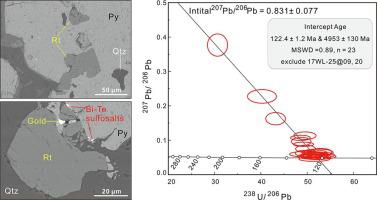当前位置:
X-MOL 学术
›
Ore Geol. Rev.
›
论文详情
Our official English website, www.x-mol.net, welcomes your
feedback! (Note: you will need to create a separate account there.)
SIMS U-Pb dating of vein-hosted hydrothermal rutile and carbon isotope of fluids in the Wulong lode gold deposit, NE China: Linking gold mineralization with craton destruction
Ore Geology Reviews ( IF 3.2 ) Pub Date : 2020-12-01 , DOI: 10.1016/j.oregeorev.2020.103838 Haoxuan Feng , Ping Shen , Rixiang Zhu , Ge Ma , Changhao Li , Jianping Li
Ore Geology Reviews ( IF 3.2 ) Pub Date : 2020-12-01 , DOI: 10.1016/j.oregeorev.2020.103838 Haoxuan Feng , Ping Shen , Rixiang Zhu , Ge Ma , Changhao Li , Jianping Li

|
Abstract Wulong is the largest lode gold deposit in the Liaodong Peninsula, northeastern North China Craton (NCC). Gold mineralization mainly occurs in the quartz-sulfide veins, which are hosted in Jurassic monzogranite and Early Cretaceous diorite dikes. Here, rutile grains are firstly identified in the auriferous quartz-pyrite vein. The vein-hosted rutiles have textural associations with quartz, chlorite, pyrite and Bi-sulfosalts and host fluid inclusions, indicating that they are unequivocally of hydrothermal origin and co-precipitate with gold. The rutile grains are characterized by high W and V concentrations, and U-shaped rare earth elements pattern with the greatest depletion in MREE. Due to excess Zr incorporation during fast rutile crystal growth process from the F-rich ore-forming fluids, Zr-in-rutile thermometers provide unrealistic crystallization temperatures (>550 °C), which are much higher than the previous homogenization temperatures data of fluid inclusions (Yu et al., 2018). All these geochemical signatures also support that rutiles formed from the hydrothermal fluids. The δ13C values of CO2 gases in low-salinity, aqueous-carbonic fluid inclusions from the mineralized quartz range from –9.6‰ to –1.7‰ (average = –5.7‰), indicating mantle/magmatic sources for the ore-forming fluids. SIMS U-Pb dating yields a more precise and robust age of 122.3 ± 1.1 Ma (n = 23, MSWD = 0.82) for the gold mineralization at Wulong. This new date is roughly coeval with the ore-hosted diorite dikes and the Sanguliu granitic pluton (most in 125–120 Ma). Such close temporal association provides additional weights of evidence for a magmatic affinity to the gold formation. Regionally, the rutile U-Pb age indicates that the gold mineralization occurs in an extensional tectonic regime, caused by the thinning and destruction of the lithosphere beneath the NCC. Meanwhile, the timing of gold mineralization is the same as the peak age of NCC destruction. Therefore, we propose that the Wulong deposit has a genetic link with this craton destruction. This is similar to numerous other Early Cretaceous gold deposits across the NCC, such as those in the Xiaoqinling and Jiaodong districts. Our study indicates that rutile is a robust U-Pb chronometer for the lode gold deposit, but may be not a good geothermometer in the case of F-rich hydrothermal fluid system.
更新日期:2020-12-01











































 京公网安备 11010802027423号
京公网安备 11010802027423号